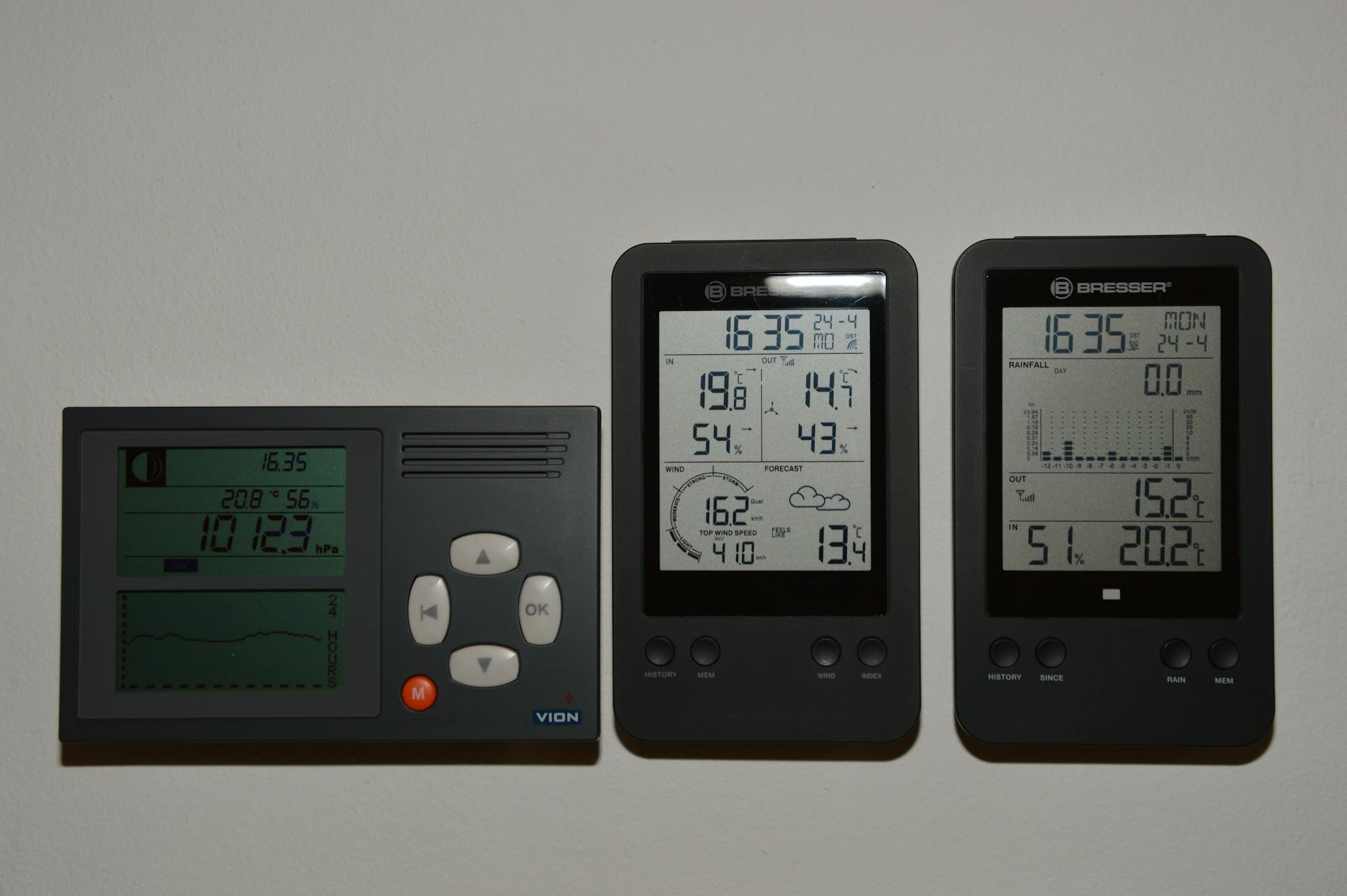
Weather commodity traders rely heavily on climate data to inform their market decisions. This data is crucial for predicting temperature and precipitation patterns, which in turn affect crop yields and commodity prices.
Climate data is sourced from various sources, including weather stations, satellites, and radar systems. Weather forecasting models, such as the Global Forecast System (GFS) and the European Centre for Medium-Range Weather Forecasts (ECMWF), provide detailed forecasts of temperature, precipitation, and other weather conditions.
Traders use this data to identify trends and patterns in the market, which helps them make informed investment decisions. For example, a prolonged drought in a major agricultural region can lead to a surge in commodity prices, as traders anticipate a shortage in supply.
A fresh viewpoint: Climate Risk Consulting
Benefits and Importance
As a weather commodity trader, you have a unique opportunity to stay ahead of the market with long-term weather forecasts. These forecasts can help you predict commodity prices with greater accuracy.

Having access to strategic planning with long-term weather forecasts is a game-changer. This allows you to anticipate market fluctuations and make informed decisions about your trades.
Forecasts optimized for the location of each utility-scale wind and solar farm on the planet are also crucial. This ensures that you're getting the most accurate information possible.
Hourly power production forecasts for any energy asset on the planet out to two years are incredibly valuable. This level of detail can help you make more precise predictions about commodity prices.
Here are some key benefits of using long-term weather forecasts in your trading strategy:
- Strategic planning with long-term weather forecasts
- Forecasts optimized for the location of each utility-scale wind and solar farm
- Hourly power production forecasts out to two years
Risk Management
Risk management is crucial for weather commodity traders, who need to predict and prepare for weather-related risks. Climavision offers a comprehensive suite of forecasting solutions designed to optimize decision-making and drive positive returns on investment.
To manage risk, traders can employ advanced models that match data on weather conditions and economic factors. Monte Carlo simulations, for example, predict the likelihood of climate events and their impact on prices.

Scenario analysis is also useful in weather data interpretation, allowing the assessment of various weather conditions' impact on markets using historical data and forecasts. This is especially useful for analyzing long-term risks such as desertification or changes in climate cycles.
Objective rules can also be a tool for risk management, with strict formalization of relationships between weather variables and commodity prices making predictions more reliable and applicable in actual conditions.
What Is a Derivative?
A derivative is a financial instrument used to hedge against risk, specifically weather-related losses. The seller of a weather derivative agrees to bear the risk of disasters in return for a premium.
If no damages occur before the contract expires, the seller makes a profit, but if unexpected or adverse weather happens, the buyer claims the agreed amount. This is how weather derivatives work to mitigate potential losses.
Regional weather has a significant impact on the physical commodity market, affecting supply directly through flooding or crop failure, and indirectly through damage to infrastructure.
Risk Management from Another Angle

Advanced models are essential for financiers, matching weather conditions with economic factors to make informed decisions. These tools can predict the likelihood of climate events and their impact on prices.
Monte Carlo simulations are one such tool that can calculate the probability of a drought reducing corn yields and its corresponding price fluctuations. This can help investors make more informed decisions.
Scenario analysis is also useful in weather data interpretation, assessing the impact of various weather conditions on markets using historical data and forecasts. This is particularly useful for analyzing long-term risks such as desertification or changes in climate cycles.
Objective rules can also be a valuable tool, formalizing relationships between weather variables and commodity prices to make predictions more reliable and applicable in actual conditions. This can help investors avoid risks like the drought linked to the El Niño phenomenon in 2023, which reduced Robusta coffee production in Vietnam.
Complex models that combine meteorological and economic variables are becoming increasingly important for traders, allowing them to extract value from data and adapt to growing market volatility.
Industry and Market Impact

Wet seasons can significantly disrupt the supply of raw materials, slowing down mine site activity and road transport, and creating a supply shortage for end-users.
Regular wet seasons can be mitigated by pre-season inventory stocking, but recent wet seasons have increased in intensity, causing long-term damage to supply, transport, and demand infrastructure.
Flooding in Pakistan in 2022, caused by heavy monsoon rains and increased glacial melt due to intense heatwaves, is a prime example of the devastating impact of extreme wet seasons.
You might like: Risk Pooling in Supply Chain Management
Energy
In the energy industry, accurate weather predictions are crucial for making informed decisions. Our real-time weather prediction tools provide a complete picture of evolving weather patterns, enabling energy traders to make timely decisions amidst rising climate volatility.
Rising climate volatility is a growing concern for energy traders, who need to adapt quickly to changing weather conditions. Our proprietary insights, coupled with access to a wealth of observational data, empower energy traders to correlate weather events with trading data effectively.

Energy companies can rely on our Horizon AI Subseasonal to Seasonal weather models for strategic planning and price prediction. These models boast superior accuracy and are updated daily, providing real-time insights into evolving weather conditions.
Having access to daily updates on weather conditions gives energy companies a competitive edge in asset level forecasting. This can lead to more accurate predictions and better decision-making in the energy industry.
Consider reading: Insurance Policies for Manufacturing Companies
Industry Revolution
The industry is undergoing a revolution, driven by the increasing impact of weather on commodity markets. Weather derivatives are being used by companies and individuals to hedge against weather-related losses, with nearly one-third of the world's GDP affected by the climate.
The connection between weather and commodity markets is becoming more obvious, with crops dependent on rain and temperature, and frosts destroying crops. This can lead to significant price fluctuations, as seen in commodity markets surpassing even cryptocurrency fluctuations since 2020.
Our Horizon AI Global weather model generates highly accurate, high-resolution forecasts to mitigate risks and predict commodity markets around the world. This model combines the latest in AI technology to assimilate billions of novel observational datapoints into our advanced NWP model.
For more insights, see: Ai Day Trader

Here are some key sectors that utilize weather derivatives to mitigate the risks of weather:
- Agriculture
- Tourism and travel
- Energy
The increasing frequency of extreme weather events is making it harder to accurately define weather risk, which is becoming harder to predict due to global warming altering atmospheric conditions. This can lead to significant disruptions in markets, as seen in the case of tropical storms, which can devastate an entire value chain in a certain area.
Understanding the timing of significant weather events and commodity supply in the affected area can increase disruption preparation in markets. This is especially true for wet seasons, which can impact the entire value chain due to the seasonality of wet seasons, but are becoming more intense due to climate change.
Take a look at this: Enhanced Due Diligence Checklist
Frequently Asked Questions
What is a weather trader salary?
A Weather Trader's average annual salary in the US is $96,774, equivalent to approximately $46.53 an hour. Learn more about this lucrative career and its benefits.
What is a weather trader job?
A weather trader analyzes market data, including weather forecasts, to inform investment decisions and develop strategies that capitalize on supply and demand fluctuations. This role involves leveraging weather-related information to make informed trading choices.
Sources
- https://www.investopedia.com/articles/active-trading/111014/it-possible-trade-weather.asp
- https://climavision.com/commodity-trading/
- https://observer.com/2024/12/how-weather-data-is-revolutionizing-commodity-trading/
- https://www.investopedia.com/terms/w/weatherderivative.asp
- https://www.sustainability.crugroup.com/article/weather-a-key-factor-in-commodity-markets
Featured Images: pexels.com


